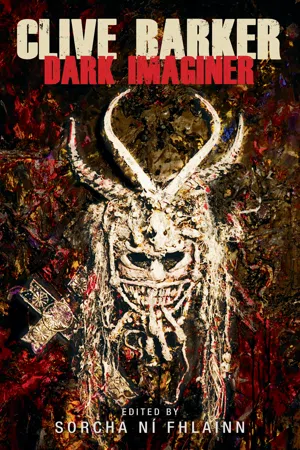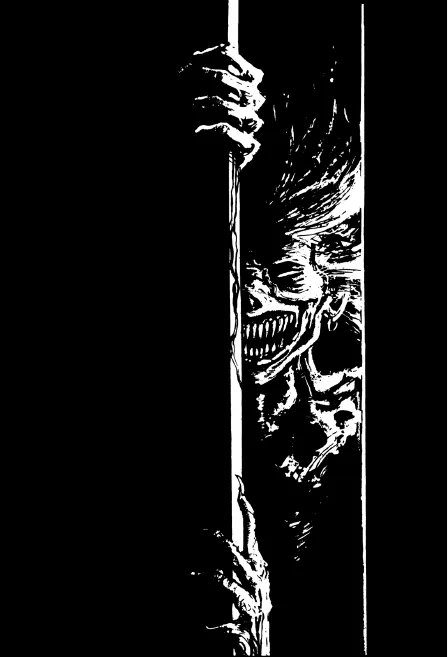![]()
Part I
Origins
![]()
1
‘Visions of another Albion’: the Books of Blood and the horror of 1980s Britain
Darryl Jones
The Books of Blood, first published in six volumes in 1984 and 1985, collectively add up to the most important work of British horror fiction of the 1980s. Together, the stories gathered across these volumes are often cited as revolutionising modern horror: my 1994 collected edition of Volumes 1–3 comes proudly emblazoned with two cover blurbs by Stephen King: ‘I have seen the future of horror … and his name is Clive Barker’ (on the front cover), and ‘What Barker does makes the rest of us look like we've been asleep for the last ten years’ (on the back).1
Formally and aesthetically, the Books of Blood are clear products of their time. The short-form horror fiction anthology was enduringly popular in postwar Britain, a familiar feature in bookstores and public libraries, and increasingly so on television from the mid-1960s. Published in 30 annual volumes between 1959 and 1989, and altogether selling some 5.6 million copies, Herbert Van Thal's Pan Books of Horror Stories series was one of the most distinctive British publishing phenomena of the postwar decades.2 Their lurid covers were a familiar presence, particularly in working-class homes (we had two volumes at home as I was growing up in the 1970s – Volume 1 and Volume 19), and the Pans provided a point of entry into adult horror fiction (or into adult fiction, or into the adult world) for two generations of postwar readers. It was through Van Thal's selections that many readers first encountered a variety of classic and, increasingly, modern horror writers (Stephen King's ‘Graveyard Shift’, for example, appeared in 1980's Volume 21). Clive Barker's own experience of encountering the series as a schoolboy is entirely typical:
I then moved on to ‘The Pan Books of Horror Stories’ which I just devoured – I thought they were wonderful. Then I would retell these stories to my friends, probably elaborating outrageously as I went along. … It did become something of a preoccupation with me. I was a podgy, slightly shortsighted schoolboy – a classic wimp … However, I knew these imaginative areas where I had some kind of power. I could tell stories to people and they would listen.3
The Pan Books of Horror Stories was the most notable but hardly the only long-running horror short-fiction anthology series of the era. The rival Fontana Books of Great Ghost Stories, for example, ran through 20 volumes from 1964 to 1984, under the editorship first of Robert Aickman (who had been suggested for the job by his friend Herbert Van Thal) and then of R. Chetwynd-Hayes, and offered, at least under Aickman's editorship, a notably exclusivist, conservative canon of largely British supernatural fiction, with a strong emphasis on Victorian and Edwardian writers.
These print-medium anthologies were in turn complemented by a series of high-profile horror-anthology television series. These series were particularly fecund across the 1970s, when any reasonably regular viewer of BBC or ITV would quickly have encountered, for example, Dead of Night (1972), Brian Clemens’ Thriller (1973–76), Nigel Kneale's Beasts (1976), Supernatural (1977), Armchair Thriller (1978–80), Tales of the Unexpected (1979–88), or Hammer House of Horror (1980). One particularly significant regular feature across the entire decade was the annual Ghost Stories for Christmas series, broadcast, often on Christmas night, between 1971 and 1979, and most famously including Lawrence Gordon Clark's versions of classic ghost stories by M.R. James.
For anyone with even a passing interest in the genre, then, the short-form horror anthology was culturally inescapable in the postwar decades. The schoolboy Clive Barker, we have seen, was particularly captivated by the Pan Books of Horror Stories. For the adult Clive Barker, struggling to make his reputation as a writer, theatre director, and filmmaker, Kirby McCauley's 1980 anthology Dark Forces: New Stories of Suspense and Supernatural Horror was most significant.4 Like the Pan and Fontana series, one of the most startling things about Dark Forces for a literary scholar is its eclecticism, its disavowal or perhaps blissful ignorance of traditional aesthetic categories and canonical hierarchies. Thus, the firmly literary Isaac Bashevis Singer, by 1980 already a Nobel laureate (he won the Nobel Prize for Literature in 1978), found himself rubbing shoulders in Dark Forces with established genre titans like Ray Bradbury, Robert Bloch, Richard Matheson, or Robert Aickman, with the current genre heavyweight champion Stephen King, with a host of minor and minorish genre writers (including Ramsey Campbell), and with a smaller group of literary unclassifiables including Joyce Carol Oates, the gothic illustrator Edward Gorey, and the conservative political theorist and man of letters Russell Kirk. In part, it was the sheer heterogeneity of Dark Forces which seems to have attracted Barker: ‘I'll have a go at that’, he later recalled thinking. ‘I'll put on 23 different hats and do everything I always wanted to do in horror fiction.’5
If the Books of Blood are aesthetic products of their time, then they are also, and a fortiori, its ideological products. It is often argued that British history entered its decisively contemporary phase in 1979, with the election of Margaret Thatcher and the ending of the postwar consensus: ‘Everyone was agreed’, writes the historian of modern Britain Alwyn W. Turner, ‘that the political and social consensus that had dominated Britain since the war had come to an end, but there was no certainty what would take its place in a new settlement’.6 If 1979 constituted a paradigm shift in British political discourse, then a cultural materialist critic would expect a concomitant shift in cultural discourse, and most particularly in artistic practice. My argument in this article is that the Books of Blood are one manifestation of this shift, and that they constitute British horror's most interesting response to the Thatcher decade. If, as Stephen King's reactions suggested, the Books of Blood were revolutionary works, then this in part reflects the fact that they were the products of revolutionary times.
What did it mean to write British horror in the 1980s? Cultural production grows out of history and context – not entirely, and not in a simplistic way; but we need to view culture as a product of its time. This much is obvious. Furthermore, as a student of popular culture, and of horror in particular, I firmly believe that these forms of production offer oblique or displaced metaphorical or symbolic articulation of prevalent cultural anxieties.
Barker has spoken and written often about his ‘perfectly sane upbringing’ in the Liverpool of the 1950s and 1960s, and of ‘the sheer banality of growing up in a town that was not of great interest to me’ – though he has also described his home town as ‘that fine but distinctly haunted city’.7 Barker is a Liverpool writer, but in complex and nuanced ways – he is not, like writers as otherwise different from one another as Roger McGough and Alan Bleasdale, an avowedly Liverpudlian writer, for whom the city provides a source, an inspiration, and a subject. There are no named Liverpool locations of any kind in the Books of Blood, nor any explicit references to the city itself: ‘The Forbidden’, which I discuss at the end of this chapter, is generally thought to be set in Liverpool, and one can infer a Liverpudlian setting from the proximity of the university and cathedral in the story, but it is never named. Indeed, with a few notable exceptions (such as the rural folk horror tale ‘Rawhead Rex’ and the nightmarish school story ‘Pig Blood Blues’) those British-set stories in the collections tend, when their locations are identifiable at all, to be set in London. However, just because the stories do not engage with any of their contexts – historical, cultural, socio-political, geographical, biographical – in a straightforward manner does not mean that these are not valid interpretive contexts from which to study the stories. It does, however, mean that we should not expect ready parallels or easy answers.
By the 1980s, when the Books of Blood were published, Liverpool was at the sharp end of British postwar, post-industrial decline, a city blighted by deprivation and unemployment. In the fevered summer of 1981, riots broke out all over Britain. The reasons for these riots are complex, but clearly directly related to the economic policies of the Thatcher government which, in its uncompromisingly ideological macroeconomic crusade to control inflation through severely limiting the money supply, wreaked social havoc, creating conditions of runawa...

